°Arcus°
Home » Creation stories » The Eastern Woodlands of North America
CREATION STORIES FROM THE EASTERN WOODLANDS OF NORTH AMERICA
ABENAKI
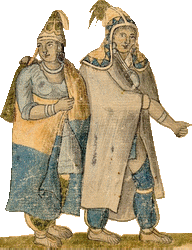
According to the Abenaki, Manitou, the Great Spirit (who is also known as Niwaskowôgan, Gici Niwaskw and Tabaldak), dwelt in the timeless, pitch black darkness of space. At some point, he was struck by a desire to fill this universe with light and life. He began to command the sparks of creation, ordering Tôlba (the "Great Turtle") to come to the surface of the deep waters to form the first landmass. Manitou then proceeded to fashion the features of the landscape upon the shell of Tôlba.
However, Manitou, having thought long and hard about the type of creatures with which to populate this new world, struggled to come up with a plan which was to his liking. Eventually, he fell asleep. However, his dreams were filled with all manner of strange things - strange things which would come to populate the land - and it was from his dream that he received the inspiration he so keenly sought. Upon waking, he noticed a beaver about its work, busily gnawing on a bough and he came to realise that his dream had become his creation.
Eventually, Manitou created manking. The first of our number was Kloskurbeh (who is better known as Glooskap). Kloskurbeh met a young boy who was formed from foam churned up by the sea which had been heated by the sun. The following day, this pair met a girl, who told them that she had been produced from a green plant as its fruit. From this, Kloskurbeh realised that humans are borne from both sea and land. He began to teach the boy and girl all they needed to know in order to survive in this world. Thereafter, he went north.
Things got off to a very good start, with the man and woman being very fruitful - so much so, in fact, that they were unable to feed them all by means of hunting ang gathering. Saddened by the fate of her offspring, the mother went to a stream and was amazed to see a green shoot emerge from between her legs. When she related this to the father, she gave him orders to kill her and plant her bones in two piles. This shocked her husband, who eventually sought Kloskurbeh's advice. Kloskurbeh told him this was Manitou's will.
Heartbroken, the father assented to his task and slew his wife, burying her bones in two piles, before mourning over her for seven months. Suddenly, he noticed that, from the twin grave, there now grew tobacco and maize. Kloskurbeh explained that the wife was not dead, but was immortalised in the form of these two plants.
THREE AGES
Abenaki mythology also posits a succession of three ages, transitions between which are heralded by the activities of Kloskurbeh. These are: -
- the Ancient Age (marked by the parity between humans and other animals);
- the Golden Age (during which humans separated themselves from their prior animal nature); and
- the Present Age.
The beings of the Ancient Age include elemental forces associated with the seasons: -
- Siguan, the youthful spirit of spring who loved summer and brought her northwards each year;
- Niben, the beautiful maiden associated with summer, whose arrival forces winter to retreat further north; and
- Peben, the spirit of winter, powerful in magic, whose stories have a soporific effect.
In addition to these may be cited the eagle-spirits Wadzoosen, whose wings create the wind (and who appears in the legends of Kloskurbeh), Psônen the bringer of snow, Kisosen the sun-bringer and Pamola an avian night-spirit who causes cold weather and spirits prioners to Alomkik in the vicinity of Mount Katahdin. Celestial beings include Kchi-awasos, whose being pursued by three huntsmen causes the movements of the stars, and the Wassan-mon-ganeehla-ak, a race whose ball games cause the Aurora Borealis. Meanwhile, beneath the earth dwelt Nanom-keea-po-da, originator of earth tremors.
Meanwhile, in the forests, lurked the enormous, cannibalistic Kee-wakw, alongside the snail-spirit Wa-won-dee-a-megw, who lived amongst the trees, as well as in the water, and who could shapeshift into the forms of an alligator, gigantic serpent or reptilian humanoid. Kita-skog or Pita-skog was a horned serpent who did battle with the Padôgiyik, seven blond white brothers with avian traits who dwelt in Lake Champlain. Another group were the ice-hearted sorcerers known as Metee-kolen-ol.
The Midewiwin was founded by the rabbit Mat-gwas, with another member, of nefarious intent, of this period being the reptilian humanoid Atosis, who was eventually blinded by Kloskurbeh's adopted son Moosbas during the subsequent Golden Age. The trickster figure Azeban or Raccoon was also active in the Ancient Age.
The Golden Age saw Kloskurbeh coming into his own. His family included his woodchuck grandmother Agaskw (also known as Nokemis), his uncle Tôlba and mother Pla-ween-noo, both turtle spirits, his adopted son Moosbas and his hounds, which had the power to change size: -
- Mool-sem; and
- his messenger, the canine-shaped loon-spirit M-da-weelh-ak.
Kloskurbeh's first attempt at creation was abortive, in the form of the stone giants known as the A-senee-ki-wakw, whose size and mass caused the earth to be injured and many animals to be crushed. Meanwhile, another giant, Oodzee-hozo (who is sometimes conflated with Kloskurbeh) brought himself into being. He is credited with the creation of Lake Champlain and many other features of the landscape.
ALGONQUIN (OMÀMIWININIWAK)
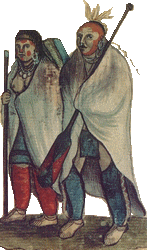
The Algonquin account of creation describes the death of Earth Mother and the creation of the natural world from her body, a feat accomplished by the culture hero Glooskap. However, the impious Malsum also made use of some elements to create dangerous plants and animals, which led to strife between the two brothers.
Eventually, Malsum succeeded in killing Glooskap by means of an owl feather arrow. Glooskap, however, returned to life, killing Malsum in turn with a fern. Malsum too revived, but was now confined to the underworld, while Glooskap ascended into the heavenly realm in a white canoe.
Some time later, the stream which provided water to the people dried up. A delegate was dispatched to the north, where he discovered that a wide stretch of water had become yellow and noxious. Nevertheless, he asked the locals for a drink, but was informed that he would need to travel further upstream to meet their chief.
It transpired that this chief was a giant who had dug a hole to dam the water at its source. When he saw the Algonquin representative, he opened his mouth to threaten him, whereupon the people and things he had devoured were visible.
Terrified, the Algonquin rushed back to his people with this information.
Glooskap had seen all of this transpire, and descended to rectify the situation. He dressed for war and shook the earth with his cry, creating a huge knife from a mountain of flint. He engaged the monster in battle and sliced open his belly, thus releasing the waters, before making the monster into a bullfrog and casting him into a swamp.
ANISHINAABE-OJIBWE
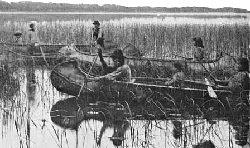
The Anishinaabe claim descent from the Abenaki and Lenape, and describe their early history in Waabanakiing, where they were visited by seven radiant humanoids, known as miigis, who taught them the arts of civilisation in accordance with the midewiwin mode of life. One of the miigis was so powerful that all humans who came into contact with it died instantly, which led this miigis to depart for the depths of the ocean, from whence they came.
From Waabanakiing, the Anishinabe migrated westward across Turtle Island (i.e. the land, which was located on the shell of a turtle) to their present homeland.
Among the Anishinabe peoples are the Ojibwe. This people describe how, at the beginning of the cosmos, the Creator sat alone within the midst of the primordial darkness, creating Mother Earth via the medium of thought. He covered the earth with plant and animal life. However, he felt lonely, thus he fashioned a man and a woman from soil, blowing life into the woman, then the man. These were given the items needed for their respective roles, the woman possessing a birch basket and the man a bow and arrows. The couple were cautioned to take good care of Mother Earth and to live in harmony with nature.
According to the oral traditions of the Ojibwe, the Anishinaabe were compelled to move ever westward in order to maintain their traditional way of life, in the face of pale-faced immigrants to Waabanakiing. They thus move in that direction via a number of small Turtle Islands, located along the St. Lawrence and Ottawa Rivers and onwards to the Great Lakes.
The first of these was Mooniyaa, then close to the Wayaanag-gakaabikaa (the "Concave Waterfalls"). At the third stopping point, the Anishinaabe divided into six septs, of which the Ojibwe were one. The Ojibwe proceeded on to Manidoo Minising (Manitoulin Island), then the "fifth stopping place," Baawiting.
The Ojibwe further divided into a northern and southern branch, with the former separating into a westerly and southerly group. The southern branch and group met up on Spirit Island at the mouth of the Saint Louis River on Lake Superior. They moved on to a "seventh stopping place," Shaugawaumikong or Zhaagawaamikong.
Meanwhile, the westerly group followed the rivers across the Great Plains to reach the Pacific Northwest.
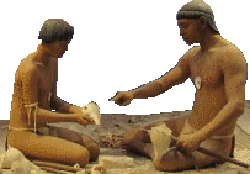
CALUSA
The Calusa people of south-western Florida believed that the world was under the control of three supernatural beings. The foremost of these ruled the physical cosmos, with the second governing human society. The third assisted in war, choosing who would emerge victorious. Corresponding to these, the Calusa believed in three souls which belonged to a person, beeing the pupil of the eye, the shadow, and the reflection.
CHEROKEE
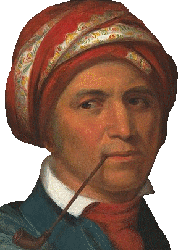
The Cherokee of the south-eastern United States believe that the earth is a floating island in the midst of a sea, hanging from the sky by cords which are attached at the cardinal points. The earth came into being when the water beetle Dâyuni'sï descended from the sky workd Gälûñ'lätï to the primordial ocean, where he dived to the sea bed and brought up mud which expanded in every direction to become the earth.
Thereafter, the other animals present in Gälûñ'lätï wished to come down, the first of which was Keel'sah'ler'ke, the buzzard, who was sent to further prepare the earth for the others. Tiring after a long flight, Keel'sah'ler'ke's wings brushed the mud, which created the mountains and valleys. Of course, this had the effect of necessitating a pause in settlement, until the earth had dried sufficiently to be populated without the possibility of such cataclysmic changes being made.
When they finally came down, they found the nascent world a dark place, and, in order to rectify this, they brought down the sun, setting it on its ever-westward course. The sun, however, was too low, which resulted in the scorching of the unfortunate Crayfish. Thus, the illuminator was placed ever higher and higher over the course of several steps.
The earliest humans were a brother-sister pair. The former struck the latter with a fish on one occasion, ordering her to multiply. She did, giving birth to a child every seven days. This resulted in overpopulation, which was rectified by decreeing that women would only give birth to one child per year.
Another Cherokee legend from Tuskegee describes the creation of the world by the earth-diver Crayfish.
CHOCTAW-CHICKASAW
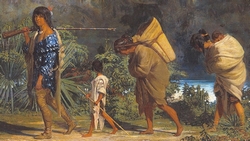
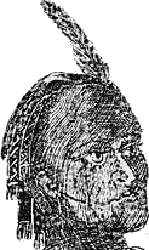
In the beginning, there was a great mound, Nanih Waiya, from which the creator - known variously as Nanapesa, Nanishta-hullo-chito, Hushtahli, Ishtahullo-chito, Aba or Uba Pike - made the first people. These crawled out through a dark passageway and, emerging on the surface, became the Choctaw tribe.
Other accounts suggest that two brothers, Chata and Chicksah, led the people from the west guided by a magical pole. They eventually came to a land in which the pole remained upright, thus meaning that they were to live here. They buried the bones of their ancestors which they had brought from the west and, from this burial place, the mound of Nanih Waiya came into being. Chatah remained near the mound, while Chicksah took half the people further north, where they became the Chickasaw tribe, who share much of the same mythology with the Choctaw. These two tribes became enemies under French and British patronage during the 17th and 18th centuries.
CREEK (MVSKOKE)

The earth was under water at the beginning of time, with only a small hillock called Nunne Chaha above sea level. There Hesaketvmese - the "master of breath" - made his home. He proceeded to form the first humans from the clay of the hill. Hesaketvmese is also known as Ibofanga, or "he who sits above."
Meanwhile, the underworld was the domain of strange, monstrous creatures, which led to Hesaketvmese further creating Brother Moon and Sister Sun, and the four directions to keep the world suspended. The earliest people were the children of Sister Sun and Sint Holo, the horned serpent, with the first couple being Lucky Hunter and Corn Woman.
IROQUOIS

In the beginning, there was no earth, only the Great Blue above, in which there was a woman who slept, dreaming dreams of a tree covered with white blossoms, which brought great brightness to the sky when its flowers opened and darkness when they closed. Alarmed by this premonition, she went to the elders in the village in the sky.
She asked them to pull up the tree - which had come into being - but they could not. They dug around its roots to allow light to enter, but the tree fell through and disappeared, leaving the sky world in total darkness.
The blame for this turn of events was put on the shoulders of the woman, who was thrown through the hole, leaving her falling and falling through empty space, with nothing below but a watery wasteland.
Fortunately, she was saved by a fish hawk, who made a pillow for her, by which means she drifted along above the waters. The hawk then called upon the creatures of the deep to assist him, asking them to point her to land to rest on.
To this end, a helldiver dove down to the abyssal depths of the ocean and brought back an amount of mud, which he smeared onto the back of a passing turtle. The ducks too brought up beakfuls of mud, while the beavers put their building skills to good use.
Eventually, the world was formed on the back of the turtle, which holds up the earth to the present day.
LENAPE
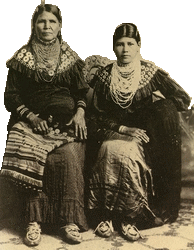
The Lenni-Lenape or Delaware are an Algonquian-speaking people of the eastern United States. This particular cosmogonic origin myth is taken from the problematic Walam Olum - though, while the whole may more closely be said to represent the ideas of the 19th century C.S. Rafinesque, there is very likely a solid foundation in the stories of this people.
The story begins with Kishelamakank, the creative deity, dwelling alone within the empty void of space. This figure became possessed by a vision of the world which was to be created and, in order to bring this vision to reality, the creator set about fashioning the elements from which it would be formed.
As demiurges, he created the great spirits of Rock, Fire, Wind and Water, who were assigned to the four cardinal points. The first of these was Muxumsa Lowanewank, the Northern Grandfather, representative of winter and the creation of the physical realm. Spring is represented by Muxumsa Wapanewank, the Eastern Grandfather, associated with the wind. He created the powers of the mind and light. Homa Shawanewank is the Southern Grandmother and is associated with fire. She created the sun and gave living things the spirit. Finally, Muxumsa Wunchenewank, Western Grandfather, is the great spirit of water and autumn. He representds both death and renewal, being the creator of blood. Other aid came from Father Sun, Mother Moon (called Nipahuma) and Mother Earth.
By this stage, all things had come into being on the new earth, and all lived together in harmony.
Nipahuma, feeling lonely, asked Kishelamakank to provide her with a husband, and Kishelamakank obliged, sending Muxumsa Pethakowe, the lord of thunder. The couple had offspring, a man and a woman, who were the first people on earth.
Unfortunately, this male-female duality was echoed throughout creation, with the forces of evil and darkness ever present, personified by Kishelamakank's archenemy, Manatu.
At this stage, Kishelamakank made Kichichax'kal, the Great Toad, to dwell on the earth to balance the waters, but Kichichax'kal was defeated by the horned serpent Maxa'xak. The earth became embroiled in turmoil, which caused Kishelamakank to dispatch a flood to purify his creation.
One of the survivors was Nanapush, who saved a number of living beings by putting them into his shirt and climbing a cedar atop a mountain. This he then fashioned into a raft. Once the rains stopped, he set about re-creating the earth. He dispatched a number of animals to the depths in order to retrieve earth, with the muskrat emerging successful, bearing soil in its paws. This soil was placed on the back of the Turtle Taxkwax and grew to form the present earth, known to the Lenni-Lenape (in English) as Turtle Island. Nanapush proceeded to breathe new life into the earth.
There was, in the midst of the earth, a tree, from whose roots grew a man. He kissed Mother Earth, who sent a woman. These were the first of the Lenape. Nanapush taught them their mode of life and, having turned into a rabbit, left for the realm of the spirits.
MENOMINEE
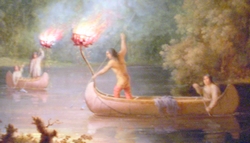
In the beginning, Mashé Manido created the earth, along with a host of lesser manidos ("spirits") of various dispositions. Of these, those which were evil went to live beneath the surface of the earth.
The most revered of these manidos was Kishä Manido, the Good Spirit, who granted a wish to a bear dwelling at the mouth of the Menominee River, allowing the animal to change its form. He chose to become the first human, Sekatcokemau. He was soon joined by an eagle, then a beaver, with the latter becoming the first female. These were soon followed by a sturgeon, with these four founding the four clans of the Menominee, soon supplemented by a wolf and a crane.
Soon, however, Kishä Manido noticed that the proto-Menominee were afflicted by ill fortune, caused by the machinations of the evil spirits beneath the surface. To rectify this, he send his kindred spirit, Mashé Wabösh or Manabush, down to earth. Mashé Wabösh entered the earth in the following way: an elderly woman, Nokomis, had a daughter, who gave birth to twin brothers. One of the children and his mother both passed away, while Nokomis secreted the surviving child beneath a wooden bowl while she performed funerary rites for her deceased daughter and grandson. Upon lifting the bowl, she was surprised to find that the child had been replaced by a small white rabbit, which she raised. This was Mashé Wabösh, the Great Rabbit.
Mashé Wabösh became a great teacher of the Menominee, founding the Grand Medicine Society. He is also responsible for giving a id to the Winnebago, the Menominee's southern neighbours and enemies, after they stole food from him.
MI'KMAQ

The Mi'kmaq are a people dwelling in Atlantic Canada and parts of Maine in the USA. They speak an Eastern Algonquian language. Their creation story - which is based around the number seven - focusses on the popular character of Glooscap.
The first deity to come into being was the Giver of Life, known as Kisu'lk, Gisloog or, occasionally, Kji Niskam ("Great Spirit"), the creator of all. After this being came Nisgam or Naku'set, the sun, the "grandfather" of the Mi'kmaq, who bestowed upon them their spirits in the form of shadows. The third entity was Ootsitgamoo or Wsitqamu'k, the earth, upon which Oetsigitpogooin - Mother Earth - brings all things to life.
A second stage in creation is heralded by three bolts of lightning dispatched by Kisu'lk. This caused the appearance of a human figure in the sand, with its head pointing eastward and his arms outstretched. A second bolt brings this figure to life: he is none other than the great culture hero Glooscap (also rendered Gellulaskiv or Kluskap). He was given senses with which he could apprehend the world around him, but it required a third bolt from the creator in order for him to achieve his desired end of being able to move around the world. Upon standing, Glooscap walked around seven times in a circle and gave thanks to Kisu'lk and Ootsitgamoo.
Thereafter, Glooscap began his peregrinations, following the path of Nisgam into the direction of the setting sun, where he came to the sea. Heading south, he came to a point at which the land was narrow enough to reveal seas on either side. Then he went north, where his progress was halted by blasts of snow and hail emanating from this cold, hoary land. Finally, he retraced his steps to the east, where he decided to make his home. For a second time, he observed the world around him, learning from Kisu'lk how to take note of his environment without disturbing it.
Eventually, Glooscap plucked up the courage to ask Kisu'lk to what end he was made. He was told that he would soon meet another. This he did, coming across an elderly woman who introduced herself as Nukumi or Nogami, his grandmother. She explained that she had been formed when a rock became covered with dew in a valley on a cold morning. This rock was then heated by Nisgam and, by noon, had assumed human shape. This was she, explained Nukumi, and she already possessed great wisdom at the moment of her appearance. Glooscap, she added, would gain great spiritual strength through respecting and listening to her.
Overjoyed at this revelation, Glooscap ordered a certain Abistanooj or Apistnew'j, a marten in the river, to come to him, whereupon he asked the animal to sacrifice his life so that Glooscap and Nukumi might live. Abistanooj assented, and Glooscap quickly dispatched the creature, snapping his neck. This action caused Glooscap to appeal to Kisu'lk to restore Abistanooj to life so that he might not lose his esteem among the animals. This was done, with another marten suddenly taking the place of the slain animal, whilst Abistanooj was again alive and swimming in the river. Glooscap and Abistanooj would become fast friends, while Glooscap came to refer to the animals as his brothers and sisters for the remainder of his days.
Nukumi prepared the marten for eating, gathering the sparks from the lightning bolt which had given Glooscap life and forming a fire by placing wood over it. This fire became Jiwukto or Ekjibuctou, the Great Spirit Fire and Great Council Fire.
Soon afterwards, Glooscap and Nukumi came upon another human while walking in the woods. This male was tall, strong and had grey eyes. Glooscap asked his name and his origin and he instroduced himself as his nephew, Netaoansom or Netawansum. He was the child of Glooscap's sister who was created when Widjosin, the east wind, caused a foam to appear atop the waves of the sea. This was driven onto some sweetgrass, where, at noon, Nisgam, along with Kisu'lk and Oetsigitpogooin, gave him life, as well as physical and spiritual strength with which to guide Glooscap. In celebration of his nephew's arrival, Glooscap ordered the salmon to give up their lives, which they did, enabling them to eat well that day.
Soon afterwards, while the trio were about various tasks, a woman appeared and sat next to Glooscap as he warmed himself by a fire. She embraced him and introduced herself as his mother, Ni'kanaptekewi'skw, who had been formed after a leaf fell to the ground and, after dew had accumulated upon it, was warmed by Nisgam, whereupon she came to life. Overjoyed at this meeting, Glooscap requested that Netaoansom gather nuts and fruits of the plants to eat.
Thus, Glooscap was able to thrive in his environment through the wisdom of Nukumi, the strength of Netaoansom and the nurturing love of Ni'kanaptekewi'skw, as well as the kindness of his animal bretheren. Over the course of his life, Glooscap would put into place the foundations of what would become the culture of the Mi'kmaq. This people were formed from two groups seven sparks from the fire Jiwukto, which became seven women and seven men, progenitors of the seven original families, who spread out to form seven hubs of settlement, in which dwelt seven clans, making a total of 49.
The creation of Glooscap's three human companions were celebrated in the sweat lodge, the braiding of the sweetgrass ("Mother Earth's hair") and the ceremonial use of tobacco respectively.
MOHAWK
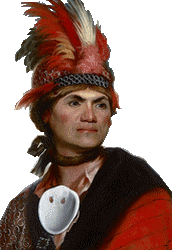
In the beginning, people lived in harmony in the sky, dwelling in houses oriented east to west in honour of the sun. In one of these, a particular man lived with a woman, who offered him protection, as this man was especially powerful. Sadly, one day, this man grew sick and passed away, the first death in the sky world. His remains were placed in a coffin.
Soon afterwards, it was discovered that the woman was pregnant, though she refused to name the father of her child, a girl who was named Aientsik ("Earth"). Aientsik cried almost constantly, a situation only assuaged when she was taken before the coffin of the man, her father. She spoke with his spirit for many hours, and it was revealed that she was to marry. She told her mother, who gave her cornbread and berries and the spirit of her father led Aientsik to the dwelling place of Tharonhaiwakon ("Sky Supporter"). The pair remained together for three days.
Shortly thereafter, Tharonhaiwakon fell ill and took Aientsik to the Tree of Light, telling her to lift it from the ground, as this would alleviate his suffering. This she did, revealing an opening through which she gazed into the void below. Tharonhaiwakon pushed her into the void and she fell, despite her best efforts, which led to her taking the roots of the "three sisters" - squash, corn and beans - into the cosmos beneath the sky realm.
This world was dark and she saw only water below, upon which there lived a variety of animals. One of them, a loon, saw "Sky Woman" plummeting to the primordial ocean. The Turtle allowed her to land on his back, with the aid of the other animals. Now safe, Aientsik asked the animals to dive for some dirt. The muskrat succeeded, and placed this on the back of Turtle. Aientsik proceeded to make a daily circuit of Turtle's back, which caused this formerly unassuming pile of dirt to grow into land enough for her to plant her crops. Thus came the earth into being.
ONEIDA
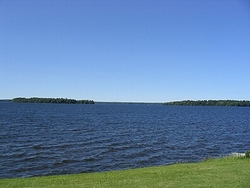
In the beginning, the earth was covered by the primordial waters. All was in darkness. Only aquatic animals stirred in the murk. In the world above, there dwelt the Great Spirit, living near a large apple tree.
One day, the Great Spirit uprooted that tree, causing the appearance of a great hole through which he could peer into the depths below. He ordered his daughter Sky Woman to gaze down and asked her to go to the watery earth. Thereafter, he dropped her down through the hole.
Sky Woman floated down towards the waters beneath, shining like a star. This caused panic among the dwellers in the waters, who hid beneath the surface of the ocean. Gradually, however, they came to the realisation that whatever was falling would need their help, and they came back up, deciding that Sky Woman needed a place to land.
To this end, Beaver dove into the waters to find soil, but tragically drowned in the process. Other animals, including the loon, also tried and failed. Finally, Muskrat succeeded, albeit at the cost of his life. He had gathered some mud in his paw, which was placed on the back of Turtle. Immediately, this mud - and Turtle - grew to a huge stature, and the land became North America. In the meantime, the swans flew up to meet their visitor and caught Sky Woman, bringing her to the new land.
As she landed, she bore twin sons, one good, the other evil. Giving birth to the latter cost Sky Woman her life. The good twin, Good Spirit, hung his mother's head in the sky, forming the sun, while her body was fashioned into the moon and stars. The remainder of her remains were buried, sanctifying the earth and causing it to become fertile. However, the Bad Spirit sought to oppose this by forming things opposite to those his brother created. He placed thorns on the plants the Good Spirit made, and caused snakes to appear, as well as rapids in the rivers.
Finally, Good Spirit made humans, with Bad Spirit creating monkeys in response. Now, Good Spirit placed his protection over his creation and ordered Bad Spirit to respect this. Bad Spirit, however, refused and the pair fought. Good Spirit eventually prevailed, dispatching Bad Spirit to a dank cave beneath the surface of the earth. Sadly, Evil Spirit's retainers can come up into this world to cause problems, particularly by causing humans to carry out evil actions.
ONONDAGA
In former times, humanoid creaturess lived in the sky of the world which lies above this one. One of their number was a woman who set about combing the hair of one of the man-beings there. She soon fell pregnant and the man-being whose hair she combed died and was placed in a coffin by his mother.
When the woman gave birth, the Ancient One - her mother - asked her who the father of the child was, but she remained silent.
One day, the child began to wail uncontrollably, which led the Ancient One to counsel her daughter to take the child to the coffin of the deceased man-being. Upon seeing this, the girl became happy. The body of the man-being gave her advice as to how to conduct herself.
Eventually, the girl married and had a daughter of her own, Zephyrs. When the child was born, the woman's husband, a chief, fell ill and sang a song, telling the other humanoids to pull up the tree near his hut, which was named Tooth. Once this was accomplished, he threw Zephyrs down through the hole.
Zephyrs - now known as Sky Woman - fell and fell. Below her was water. The animal denizens of this primordial ocean saw her and decided to help her. A number of them tried to get some earth from the bottom of the deep. Finally, Muskrat was successful (at the cost of his life), and the earth he had collected was placed on the back of the Turtle, where it became the first dry land. The woman was caught in a net fashioned by the flying animals and brought to the earth. Sky Woman and her daughter then made use of the fire they had brought, and taught the people how to live.
Eventually, Sky Woman's daughter had a nightly visitor, and became pregnant. Just prior to giving birth, she heard two males talking within her, arguing about how to be born. One was born in the usual fashion, while the other emerged from the armpit of his mother, mortally wounding her. He told his grandmother that his brother had done the deed. Hence, good and evil came to be.
PENOBSCOT
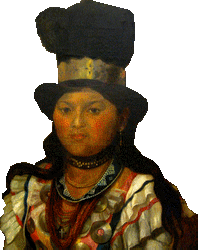
In the beginning, the All-Maker dwelt alone. In order to assist him in the work of creation, he made Helper-to-All-Maker from a wave upon the primordial ocean. Together, the pair created the world and all that is in it.
One day, as they worked, some dew fell upon a leaf. Warmed by the sun, this became First Mother. She married Helper-to-All-Maker and together the couple became the parents of the first humans.
Soon, however, the people had multiplied to such an extent that their food ran out. First Mother was deeply distressed and was compelled to petition Helper-to-All-Maker to kill her and follow instructions she gave him. Helper-to-All-Maker refused, and approached All-Maker for counsel. All-Maker advised him to do what she told him and, eventually, he was forced to accede to her request. Helper-to-All-Maker killed his bride when the sun was at its zenith, and had their sons drag her over those parts of the earth which remained empty. This would cause her flesh to be removed from her cadaver by the action of the sharp rocks.
Then, after seven moons, they were to return and find food which had emerged from where her flesh was torn away. These were in the form of beautiful plants whose foliage reminded them of First Mother's silken hair. This was maize, hence her new name - Corn Mother. Through this foodstuff, Corn Mother returned to her people on a yearly basis.
SENECA (ONÖDOWÁGA')
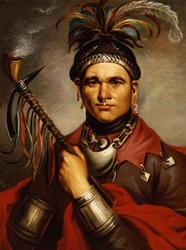
In the beginning, the entire earth was covered in water. The only life forms present were aquatic animals, with the ducks being the most populous group. The people dwelt above in the sky with Great Chief.
One day, the daughter of Great Chief fell ill and appeared to be dying. A wise man dreampt that she should be placed by a certain tree and that the tree ought to be dug up. This was done and a man who was opposed to the digging up of the tree kicked the girl into the hole created in a fit of pique.
Downwards she fell. The birds, however, saw this and joined their efforts to provide her with a soft landing place. When they tired, they placed the girl on the back of Turtle. They soon realised, however, that this new member of the population would need some land upon which to live, so they sent Toad down into the depths, from whence he brought back some soil.
The woman - Sky Woman - placed this soil on Turtle's back and it began to grow, along with its support, until there was plenty of room for her to dwell on. The girl lived happily, making a home for herself and giving birth to a girl. The pair worked the land.
The girl gave birth to twin boys, Othagwenda ("Flint") and Juskaha ("Sapling"). Sky Woman preferred the latter and disliked Othagwenda, so she placed him in the tree, while she taught Juskaha how to make things and live as a huntsman. She noticed, however, that Juskaha would return without his bow and arrows, and discovered that he was giving them to Othagwenda. Finally, he brought his brother home.
After some time, the brothers decided to enlarge the earth. Othagwenda created rough country and Mosquito. Mosquito was enormous, and had the ability to chop down trees. Juskaha was horrified, thinking Mosquito could ruin creation and slay the humans they planned to populate the land with. This led him to shrink Mosquito to his present dimensions.
Othagwenda was no fan of Juskaha's creations either. These included maples which dripped their syrup and fat animals who would be no match for human guile, so he made the animals faster and slimmer, while causing the maples to drip sap which needed to be boiled to form syrup.
Eventually, the pair came to blows. Juskaha killed Othagwenda, but it was too late for him to rectify the latter's actions.
WINNEBAGO (HO-CHUNK)
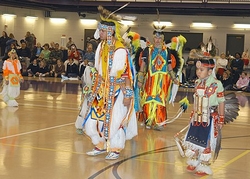
In the beginning, Manuna, the Earth Maker, became conscious and realised he was alone. He found himself resting on some form of matter, and broke off a piece, from which he made a ball, which he propelled into space. This was the world.
Then, he covered the earth with grass, then created trees and the four directions, before bringing the mountains into being. This stopped the wild spin of the planet.
This new equilibrium was marked by the emergence of the sun, whereupon Manuna formed the various types of animal to dwell on the earth.
Last of all, he thought of humans, and created them from a piece of earth, made into his own image, and by the placement of his finger into each of the orifices to give the people senses. Finally, he breathed life into the man, so that he might converse with Manuna.
WYANDOT (HURON)
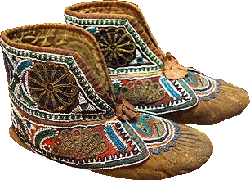
Within this watery world dwelt aquatic animals. After some time, a woman fell through a rend in the sky. Two loons saw her fall and made a place for her to sit. Soon, Turtle heard the loons crying for help and called upon the other animals to join in. Turtle then led a number of animals in seeking earth for her to sit on from the bottom of the waters. Toad was successful, bringing up a little water in his mouth. The woman put this on the shell of Turtle, which eventually became the earth, after the mud grew and grew. Turtle still holds up the earth to this day.
This divine lady gave birth to two twin boys of opposite temperaments. The good one was born in the normal way, but his brother forced his way through the side of his mother, bringing about her death. When she was interred in the earth, the plants sprang up from the ground in which she lay. These included the pumpkin vine, maize and pole beans.
The woman's sons were named Tijus-kaha and Tawis-karong. They were tasked with preparing the earth for humanity. Tijus-kaha, the good twin, made the animals which would be useful to mankind, but Tawis-karong created all manner of monsters and menacing animals. One of these was a huge toad, which drank all of the earth's fresh water resources. This led to an expedition by Tijus-kaha into his brother's domain, in order to recover the waters. This was done by slicing open the toad. In addition, he made Tawis-karong's aberrant creations smaller and less threatening.
Some time later, Tijus-kaha was warned by his mother about his brother in a dream. They eventually met and decided to fight a duel to decide who would rule the earth. It transpired that Tijus-kaha could only be killed by a bag of beans, while Tawis-karong could only die by means of a deer antler or other animal horn. Tawis-karong had mastery over the earlier part of the fight, but Tijus-kaha eventually emerged victorious. Tawis-karong, however, was not done, for he had been translated to the furthest west - the realm of the dead where people of all races will follow him.
YUCHI
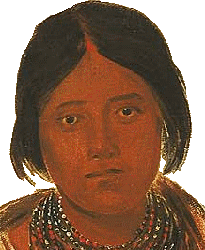
The world had originally been covered by water. Lock-chew the Crayfish answered the call of Wind and dived deep to stir the muddy seabed, gathering it together to make a mound. The people who dwelt at the bottom of the water, however, were wary of this intruder and saught to capture Lock-chew, who evaded them. he continued his work until the mount of mud reached above the surface of the water.
The land was soft, so Wind asked who would spread it and harden it. Buzzard tried, but succeeded only in forming hills and valleys. Hawk also tried. Then Wind asked who would create light, for the world was dark. Yo-hah the Star tried first, but the light penetrated little further than his immediate surroundings. Next to try was Shar-pah the Moon. This was better, but still not sufficient. T-cho the Sun went next, going to the east and casting light everywhere.
As he travelled over the earth, a drop of blood fell onto the land, from which emerged the first people, who became known as the Yu-chi, children of T-cho.
Eventually, there was This World, with an Upper World and Lower World above and below. Once, group of extraordinary creatures descended from the Upper World, before returning. The people of This World eventually grew into tribes with villages and agricultue, becoming skilled craftsmen and builders.
